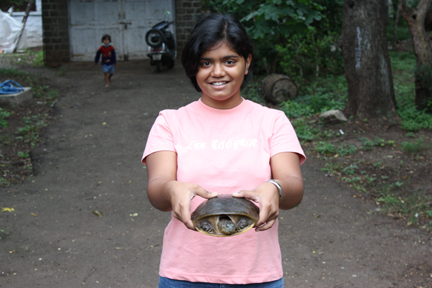Green Defenders
REPTILE RESCUE SQUAD - FLAPSHELL TURTLE
by
Aditi Baindur
If you are a tortoise and go for a very long walk on the CME campus far from your home, you may very soon find that you are back where you started from and named ‘Myrtle’ on top of that.
It was during the summer holidays last year that my Dad got a call at office from Bhattacharya Uncle. His daughter Shreya had found a tortoise in the garden. What, he asked, should be done? Naturally, Dad felt, it had to be restored to its habitat.
He picked me up, our tortoise books and we soon reached Bhattacharya Uncle's bungalow adjoining Holloway School. The turtle was in the lawn surrounded by Shreya and Priyansh, Bhattacharya Uncle's kids and Shrey Kamoji. It had withdrawn itself into its shell.
The back was coloured “muddy-shoddy, grey, brown, black, ochre”. It had three black stripes on its head.
I picked it up and turned it over. We saw that had got flaps to hide its legs under and realised that this was the Indian Flapshell Turtle or Lissemys punctata.
Now the turtle struggled to be put down. No sooner had this been done than its knobby, ridgy sleg with claws emerged and it scurried away along the lawn but was repeatedly recaptured while we pored over our books. We wanted to know why the turtle was wandering
so far from the CME lakes. Our handbook by J.C. Daniels had this to say -
“the adults and young make long journeys during the rainy season, which is probably the reason for the species being so widespread….”
Indian Flap-shell turtles are the “aam janta” in the turtle community of CME and occupy the four lakes and the river. They are also found amongst the reed-beds, ponds, quarries and marshes and the 2 km long rowing channel. The nearest water body or marsh
to Bhattacharya Uncle's house is more than a kilometer away.
The turtle had crossed roads, houses, gardens, fences, ditches and braved the dangers of stray dogs and turtle-eating people to land up where it did! If allowed to roam free, it would head deeper and deeper into the CME campus and surely would be killed.
Shreya asked ‘is it a boy or girl’? Since it is nt easy to identify the sex of a turtle just by looking at it, the children decided, (two girls both older vs two boys both younger), that it looked feminine and soon names for ‘her’ were being proposed. It
was decided that her name was actually “Myrtle” and that she would be a very good pet! Undying vows were made to look after the creature if only they could have it please, pleeassee...
Mindful of what the parents would have to say to this, Dad pointed out that Myrtle fed on shrimps, insects and worms from within the water (they actually eat that and some vegetation too) and her family was probably missing her.
It was decided to restore Myrtle to her home. Everybody set out in our red Maruti van for the rear Nashik gate. There Myrtle was released at a suitable spot upstream into the marshes near the CTW lake. The last photo that we have of Myrtle is of a grinning
Shrey Kamoji holding the turtle last before its release. And the reason for that is, as soon as we set it on the ground some good seven-eight feet from the water’s edge, Myrtle became greased lightning and vanished before we could photograph her!
So Myrtle the turtle went back to tell tales to the grand-turtles with a new name to boot.

Shreya holding the Flapshell turtle that she found
Image credit - Ashwin Baindur
|